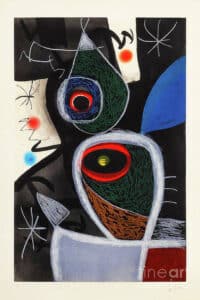Joan Miró: The Maestro of Surreal Abstraction
Joan Miró, an artist of extraordinary talent and vision, stands as a towering figure in the world of modern art. Known for his surreal and playful abstract works, Miró’s art challenges traditional perceptions of reality, inviting viewers into a realm where dreams and imagination reign supreme. His unique fusion of abstraction and surrealism creates an enchanting space for exploration and interpretation.
The Artistic Journey of Joan Miró
Born in Barcelona in 1893, Joan Miró’s artistic journey was marked by a constant search for a personal language of expression. Early in his career, he dabbled in different styles, including Fauvism and Cubism, but it was his foray into Surrealism and later, his unique blend of abstract art, that defined his legacy.
Early Influences and Evolving Style
- Miró’s early works were influenced by his Spanish heritage, the landscapes of Catalonia, and the bright colors and forms of the Fauvist and Cubist movements. However, as he delved deeper into his artistic practice, his style evolved, becoming more abstract and dream-like.
Surrealism and the Unconscious Mind
- Miró’s involvement with the Surrealists in Paris in the 1920s significantly shaped his artistic direction. Influenced by the ideas of Sigmund Freud, the Surrealists sought to tap into the unconscious mind, and Miró embraced this concept wholeheartedly, allowing his subconscious to guide his creative process.
Defining Works of Joan Miró
Among Miró’s extensive body of work, certain pieces stand out for their innovative approach and profound impact.
“The Birth of the World”
- “The Birth of the World,” painted in 1925, is a quintessential example of Miró’s mature style. This painting represents a cosmos of creation, where floating forms and spontaneous lines suggest a universe coming into being. Its abstract composition encourages viewers to let their imaginations roam, seeing beyond the canvas into a world of endless possibilities.
Other Notable Works
- Miró’s oeuvre is filled with other significant works like “Harlequin’s Carnival” and “The Tilled Field,” which also exemplify his unique blend of surrealism and abstraction. These paintings are characterized by their vibrant colors, whimsical shapes, and dream-like atmospheres.
The Playful and Whimsical Nature of Miró’s Art
Miró’s art is often described as playful and whimsical. His use of bright colors, organic shapes, and fantastical creatures create a sense of joy and wonder. This playful nature is not just aesthetically pleasing but also reflects Miró’s deeper philosophical views on art and life.
Art as a Realm of Freedom
- For Miró, art was a space of absolute freedom. He believed in the power of art to transcend the mundane and open doors to new worlds. His paintings are a testament to this belief, showcasing a universe where the rules of conventional reality do not apply.
A Critique of Materialism
- Miró’s whimsical forms and fantastical landscapes can also be seen as a critique of the materialism and rationalism of modern society. In his art, he sought to offer an escape, a return to a more innocent and imaginative state of being.
The Impact and Legacy of Joan Miró
Joan Miró’s contribution to the art world extends far beyond his individual works. His innovative approach and distinctive style have left an indelible mark on the world of modern art.
Influence on Abstract Art and Beyond
- Miró’s fusion of surrealism and abstraction influenced a multitude of artists and art movements. His work paved the way for future abstract artists, encouraging a freer, more intuitive approach to art-making.
Continuing Relevance and Inspiration
- Today, Miró’s art continues to inspire artists and art lovers alike. His ability to tap into the subconscious and embrace the whimsical resonates with contemporary audiences, reminding us of the power of imagination and the endless potential of artistic expression.
Conclusion: Embracing the Unexpected with Joan Miró
Joan Miró’s artistic legacy is a celebration of the unconventional. His works, especially “The Birth of the World,” stand as a testament to the unbridled creativity and imaginative freedom that abstract art offers. They encourage us to embrace the unexpected, to let our imaginations run wild, and to find beauty and meaning in the whimsical and nonsensical.
Miró’s art challenges us to let go of preconceived notions and to immerse ourselves in a world of possibility. It is a constant source of inspiration, a reminder that in the realm of art, boundaries can be fluid, and the unconventional can not only thrive but also illuminate new ways of seeing and understanding the world around us.

